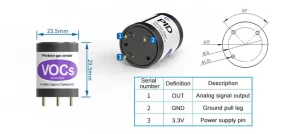In the modern era, with an increasing awareness of health and well-being, the quality of the air we breathe indoors has become a critical concern. Indoor air pollution poses a significant risk to human health, contributing to respiratory problems, allergies, and other ailments. As a result, there has been a growing demand for effective solutions to monitor and improve indoor air quality (IAQ). One of the most promising advancements in this field is the development of gas sensors, which are revolutionizing IAQ control.

Gas sensors are devices designed to detect and measure the concentration of various gases in the air. They operate on the principle of chemical or physical reaction between the gas molecules and a sensing material, producing an electrical signal that is proportional to the gas concentration. These sensors can detect a wide range of gases, including volatile organic compounds (VOCs), carbon dioxide (CO2), carbon monoxide (CO), nitrogen dioxide (NO2), and many others.
The integration of gas sensors into IAQ monitoring systems has brought about a paradigm shift in the way indoor environments are managed. Traditionally, IAQ monitoring relied on manual sampling and analysis methods, which were time-consuming, expensive, and often yielded limited data. With the advent of gas sensors, real-time monitoring of indoor air quality has become feasible, providing continuous and accurate measurements of pollutant levels.
One of the key advantages of gas sensors is their ability to detect low concentrations of harmful gases that may pose health risks even at levels below regulatory standards. VOCs, for example, are emitted by a variety of household products, such as paints, cleaners, and furnishings, and can have detrimental effects on human health. Gas sensors can detect these compounds at trace levels, allowing for timely intervention to mitigate exposure risks.
Moreover, gas sensors enable proactive management of indoor air quality by providing insights into sources of pollution and trends in pollutant levels over time. By identifying areas of concern and implementing targeted interventions, such as ventilation adjustments or pollutant source control, building managers can effectively improve IAQ and create healthier indoor environments.
The widespread adoption of gas sensors in IAQ monitoring is also driving innovation in sensor technology, leading to the development of smaller, more affordable, and more reliable sensors. Advances in sensor materials, such as nanomaterials and metal-organic frameworks, have enhanced sensitivity, selectivity, and durability, enabling the detection of a broader range of gases with greater precision.
Furthermore, the integration of gas sensors with Internet of Things (IoT) platforms and cloud-based analytics has opened up new possibilities for IAQ management. These connected sensor networks enable remote monitoring and control of indoor air quality parameters, allowing building owners and facility managers to access real-time data and receive alerts about potential issues. Machine learning algorithms can analyze large datasets to identify patterns and correlations, enabling predictive maintenance and optimization of IAQ strategies.
The impact of gas sensors on indoor air quality extends beyond commercial and residential buildings to various other indoor environments, including schools, hospitals, offices, and industrial facilities. In educational settings, for instance, IAQ plays a crucial role in student health and academic performance. By deploying gas sensors in classrooms and common areas, schools can ensure a safe and conducive learning environment for students and staff alike.
Similarly, in healthcare facilities, maintaining high indoor air quality is essential for patient recovery and infection control. Gas sensors can help healthcare providers monitor air quality parameters, such as airborne pathogens and volatile chemicals, to minimize the risk of healthcare-associated infections and ensure the well-being of patients and healthcare workers.
In industrial settings, where exposure to hazardous gases is a common occupational hazard, gas sensors are indispensable for ensuring worker safety and compliance with occupational health and safety regulations. By continuously monitoring the air for toxic gases and implementing appropriate control measures, employers can protect their employees from potential health risks and prevent workplace accidents.
Looking ahead, the future of indoor air quality control lies in the continued advancement and integration of gas sensor technology with other smart building systems. Emerging trends such as smart HVAC systems, building automation, and energy management systems present opportunities for synergistic integration with IAQ monitoring solutions, enabling holistic approaches to indoor environmental quality management.

In conclusion, gas sensors represent a transformative technology that is revolutionizing indoor air quality control. By providing real-time, accurate, and actionable insights into indoor air pollution, gas sensors empower building owners, facility managers, and occupants to create healthier and more sustainable indoor environments. As the demand for IAQ solutions continues to grow, gas sensors will play an increasingly vital role in safeguarding human health and well-being in indoor spaces.
 : +86 155 8830 2704
: +86 155 8830 2704 : jxdziot@gmail.com
: jxdziot@gmail.com
